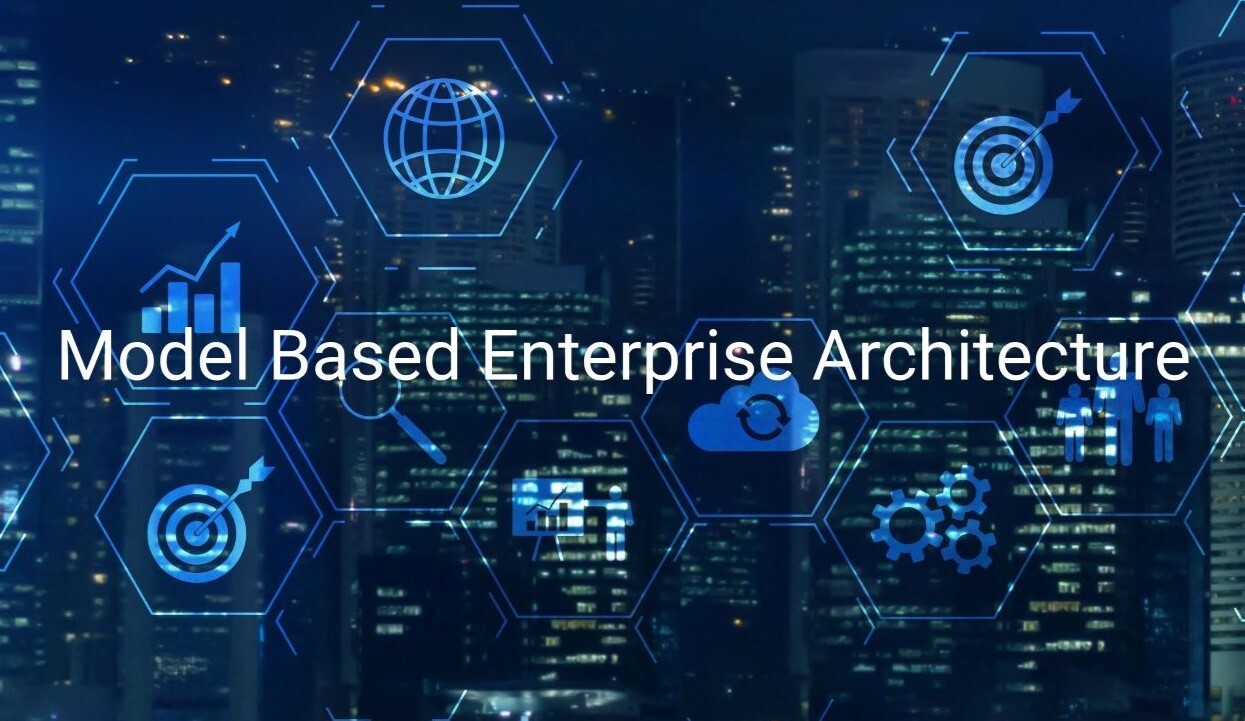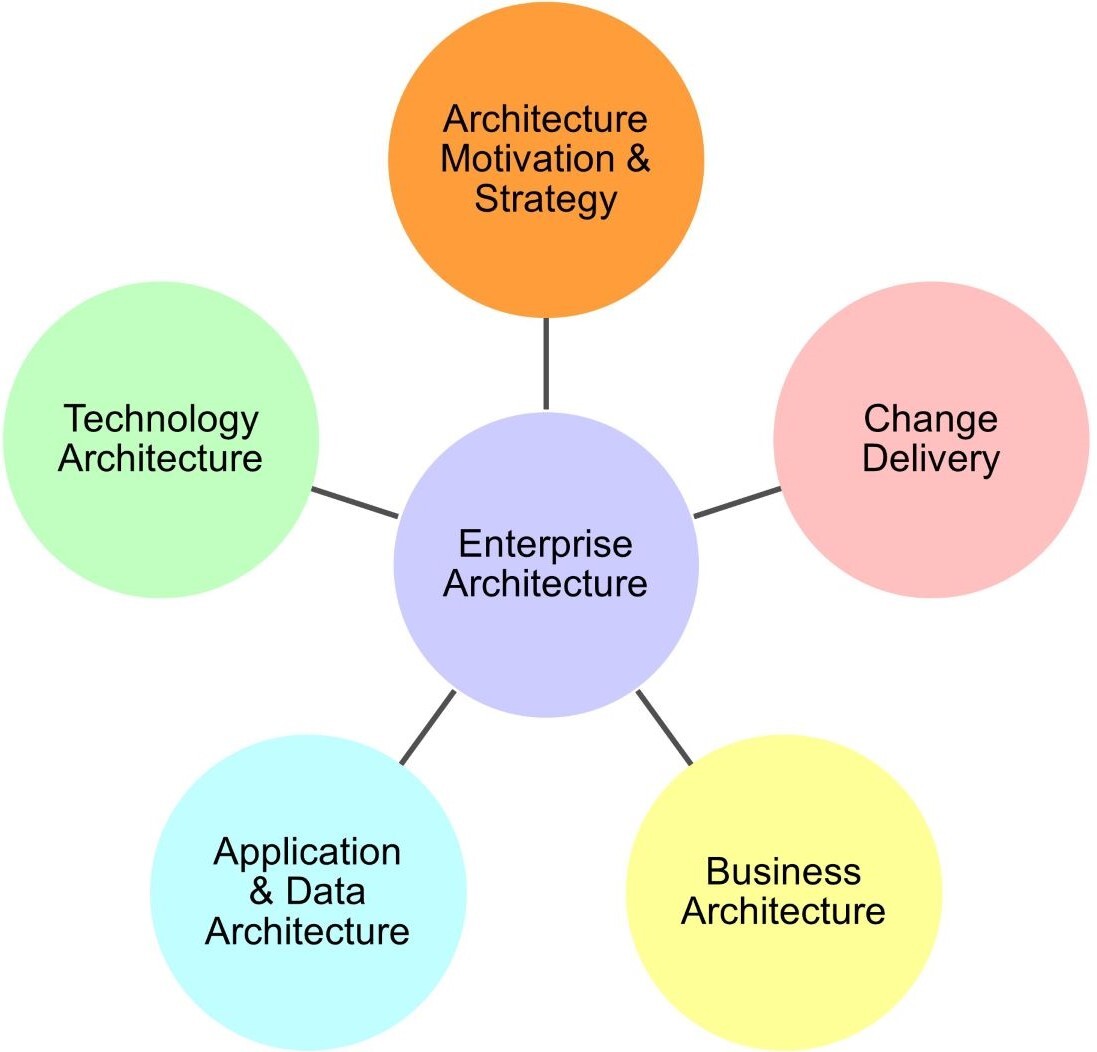Model Based Enterprise Architecture (MBEA)

5 Key Enablers You Need to Know
Whether viewed as a business function, IT discipline or organisational blueprint, the purpose of Enterprise Architecture (EA) is to help organisations align their business processes, applications, data and technology to better achieve their strategic goals. Over time it is common for these layers of the organisation to drift and separate as each deals with its own challenges and set of priorities. To align these, EA provides organisations with a unique insight into their structure and operation, extending from strategic decision making to the delivery of technology-enabled change. By understanding current capabilities coupled with business goals, EA is able to help organisations chart their way to their desired future state.
EA typically covers the following key aspects (also known as architecture domains) of an organisation.

Architecture domains
Architecture Motivation & StrategyDefines the organisation’s business drivers, goals, resulting strategy and required capablities that the EA must support.
Business Architecture
Focuses on the internal structure and operations and the external interactions of the organisation.
Application & Data Architecture
Identifies the applications and data needed to support the business, including how systems are connected, what data flows between them, and how the data is stored, managed and accessed.
Technology Architecture
Encompasses the physical hardware, software, networks and other IT infrastructure required to support the applications and data used by the organisation.
Change Delivery
The ultimate aim of EA is to facilitate the effective delivery of technology-enabled business change needed to achieve strategic goals. In this respect, EA helps to ensure that both business change and technology change are implemented and aligned.
What is MBEA?
Model-Based Enterprise Architecture (MBEA) is the practice of using models as the primary method of analysing, documenting and communicating EA. These models represent the various aspects and elements of the organisation and, just as importantly, the relationships between them.In contrast to traditional document-based EA, which relies on lengthy text documents and static diagrams, MBEA focuses on the creation and use of dynamic, integrated models, built using industry standard notations such as ArchiMate, UML (Unified Modeling Language), SySML (Systems Modelling Language) or BPMN (Business Process Model and Notation). Together, such models provide an end-to-end view of the current and future state of the organisation in a structured, visual way.
MBEA allows a more interactive and flexible approach to EA, where changes can be visualised, tested and understood in real-time. It also greatly faciliates collaboration by providing stakeholders from the various parts of the organisation - such as the business, IT and operations – with a shared understanding of how the different parts of the organisation fit together.

Benefits of MBEA
The adoption of a MBEA approach provides a wide range of benefits, making it a powerful tool for organisational growth and transformation.Improved decision-making
MBEA offers a holistic, up-to-date view of the organisation’s structure and operations, both at a business level and technically. By providing a visual and interconnected model, decision-makers can quickly assess the impact of changes to processes, systems or technologies. This helps organisations make informed decisions and minimise risk by understanding the cascading effects of changes across the enterprise.Better collaboration between teams
MBEA allows for a shared understanding of the organisation’s structure. With all stakeholders - from business leaders to IT – being able to access the same models, collaboration improves and silos are broken down. This leads to better alignment between business strategy and IT operations.Faster response to change
The ability to quickly adapt is the difference between success and failure in today’s fast-moving business environment. MBEA supports this much needed agility by enabling organisations to rapidly analyse and adjust their structure and behaviour in response to new opportunities or challenges. Whether adapting to regulatory changes or taking advantage of new technology, MBEA makes it easier to plan and implement changes, while minimising risk and disruption.Consistency and accuracy
Models are precise and structured, allowing organisations to document their EA in a consistent and accurate way. This reduces inconsistencies, duplication of information and errors that can occur in traditional document-based approaches. With the right tools and approach to governance, changes to the architecture are easily traceable within the model, allowing them to be monitored and controlled more effectively.Efficient use of resources
By having a clear, modelled view of the organisation, inefficiencies and redundances can be identified and eliminated, processes streamlined and automated, and resources focused on adding business value. This leads to productivity gains, cost savings and more efficient use of staff and technology.
Key enablers of MBEA
Like all transformative initiatives, MBEA needs a number of key enablers to be established early on in order to to achieve success.1. Buy-in from senior leadership
The first and perhaps most crucial enabler for establishing a successful MBEA is securing the support of your organisation’s senior leadership. EA spans multiple domains, from business processes to technology platforms, which makes leadership support essential for the practice to be impactful.Without the active endorsement of senior leaders, the initiative is likely to fail due to lack the necessary resources, priority and departmental cooperation. To succeed, the role of senior management is not only to allocate budget and resources but also to champion MBEA as a cross-deparmental function that all business units should support and align with.
Best practices
- Present a clear business case that outlines the long-term value of MBEA, such as improved decision-making, cost optimisation and risk reduction.
- Demonstrate quick wins to gain momentum and prove the effectiveness and value of the approach early on.
2. Well trained team
MBEA requires a skilled and knowledgeable team capable of analysing complex business processes and technologies, and understanding how to apply MBEA methods and tools to creating models of value to the organisation.A trained team with proficiency in MBEA tools, modelling languages (such as ArchiMate or UML) and best practices is therefore essential. Using their knowledge and skills, the team must be able to create models that accurately reflect the organisation’s current and future state, and be able to communicate these to business and technical stakeholders at all levels within the organisation.
Moreover, continuous training and development are needed ensure that the team stays current with evolving MBEA standards, methodologies and tools.
Best practices
- Invest in both formal training programs and on-the-job learning from experts to develop expertise in MBEA.
- Foster a collaborative learning environment where team members can share knowledge and improve together.
- Ensure your team is adequately resourced to meet the needs of the organisation. For large and complex systems in particular, recruit process and technically focused specialists for modelling different aspects of the architecture.
3. Defined methodology and standards
A well-defined MBEA methodology and a set of standardised modelling conventions is a commonly overlooked but essential ingredient needed to guarantee production of clear, consistent and accurate models.A documented MBEA methodology should include instructions on the correct use of modelling standards and tools, and provide best practice guidance extending from stakeholder engagement and requirements discovery, to model creation, verification, validation, use and maintenance.
As with having a well trained team, use of standardised modelling languages, processes and tools is vital for ensuring fit-for-purpose, high quality models that can be used by different teams and departments across the organisation. Without this enabler, models will quickly become inconsistent, disjointed and impossible to reuse or extend. With multiple versions of the "truth" emerging and models becoming increasingly difficult to produce or maintain, the organisation will soon learn to stop using them.
Best practices
- Adopt and tailor an established framework that fits the needs of your organisation. This could involve utilising a standard EA framework such as TOGAF or Zachman; or following a hybrid approach by tailoring a framework already in use within your organisation, such as Scaled Agile Framework (SAFe) or ITIL, to include MBEA practices.
- Develop a set of modelling guidelines, covering areas such as naming conventions, use of the modelling notation, visual styles and documentation requirements, as well as goverance processes for model change and version management.
- Conduct regular reviews and updates both to improve the methodology and to adapt to evolving business needs and advances in technology.
4. Shared centralised model repository
To enable collaboration and ensure that architecture models are accessible and up-to-date, a shared centralised model repository is essential. As with any centralised data store, the model repository provides users with controlled access to a common source of data for adding and linking content.With a centralised repository, modellers, architects and other users can collaborate in real-time, minimising duplication and inconsistency within the model, and accelerating decision-making and delivery. Additionally, a centralised repository provides a robust foundation for governance and version control.
While modelling can be performed using tools linked to individual user repositories, this is neither a robust nor scalable approach to MBEA.
Best practices
- Invest in MBEA modelling tools that support real-time collaborative working and version control via a centralised model repository.
- Pay close attention to defining the repository structure, i.e. how model content is organised.
- Set clear policies and controls regarding viewing, adding and updating model content.
- Ensure the tool and repository support model publication in various formats, bulk import and export of model content and, ideally, integration with other tools, such as requirements management systems and asset registers, for model linking and sychronation.
5. Effective change management and comms
Implementing a MBEA function often represents a significant shift in how an organisation operates, particularly in how teams collaborate and make decisions. This should not be underestimated. As with any significant organisational change, an effective change management and communication strategy is crucial to help guide transformation and ensure the function is embraced across the organisation.Change management should focus on helping employees understand the value of MBEA and how it will add value that improves their day-to-day work. Communication and consultation are key in addressing any concerns and ensuring MBEA meets the needs of users and teams across the organisation.
Best practices
- Establish a structured change management plan that includes training, stakeholder consultation, and clear milestones for implementation.
- Regularly communicate the progress, benefits, and expectations to all stakeholders, especially those directly impacted by the changes.
- Use stakeholder feedback to continuously improve the adoption process and address challenges at the earliest opportunity.
Conclusion
Successfully establishing a MBEA enables organisations to significantly increase alignment between business and IT, improve decision-making and enhance their ability to respond to change. However, this is contingent on a number of critical enablers, namely, securing leadership buy-in, building a trained and skilled team, defining a clear methodology and standards, enabling centralised collaboration through a shared repository, and managing the transition to MBEA effectively through a well-planned change management and communication strategy.By putting these foundational elements in place, organisations can significantly enhance their ability to establish a robust and sustainable MBEA function that delivers real business value and equips them to meet business and IT challenges both now and in the future.



